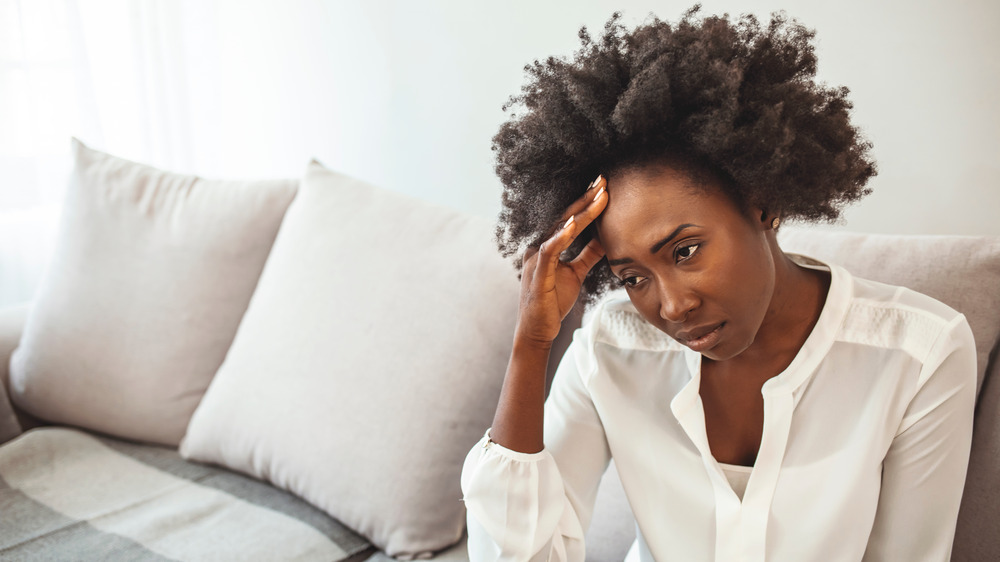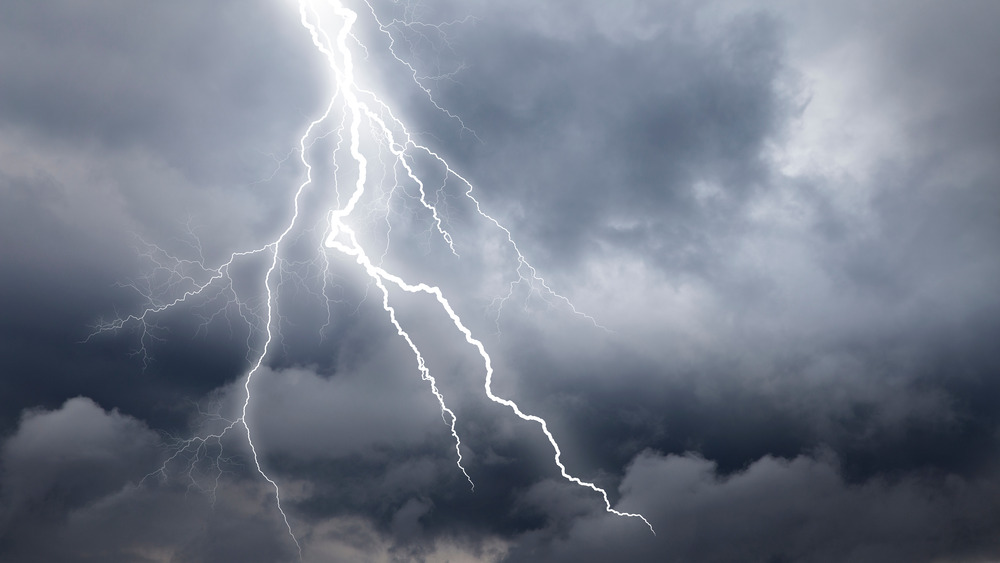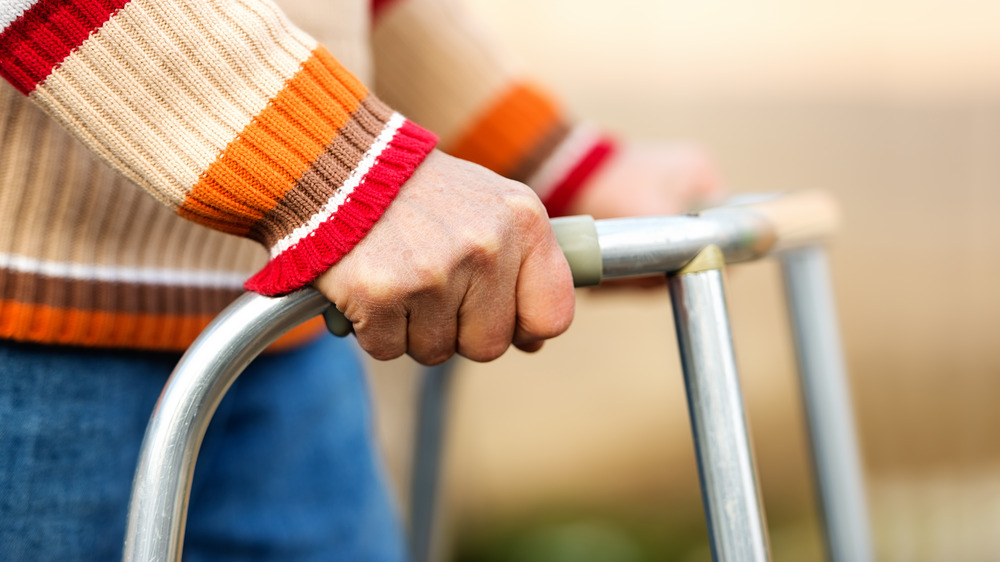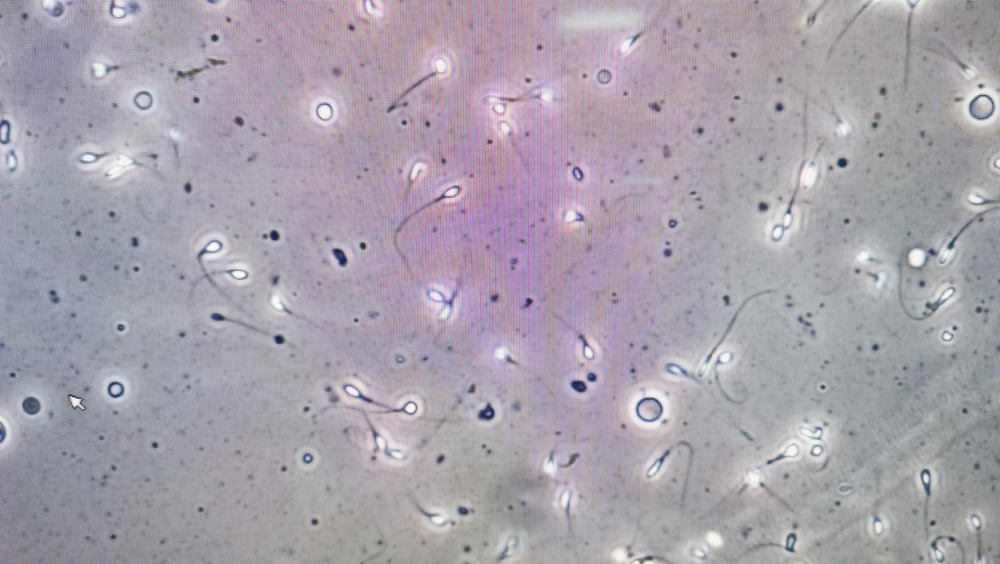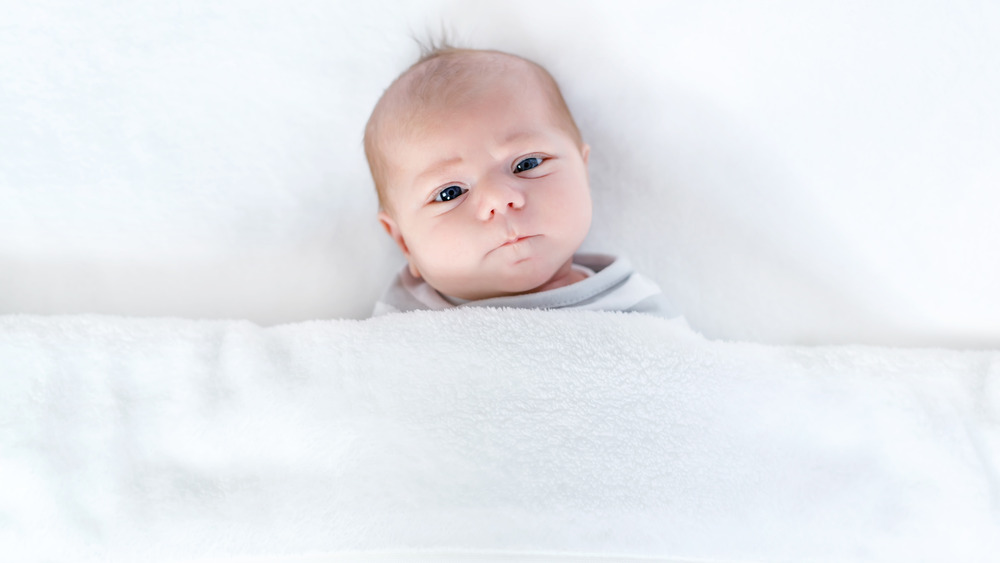Strange Things That Happen To Your Body In The Spring
The reason we have spring, or any season, is a matter of degree. More precisely, 23.5 degrees, which is the amount that the Earth is titled relative to the plane of its orbit (via Smithsonian Science Education Center). That means our portion of the earth gets tilted more towards the sun at certain times of the year than others. And that results in the annual cycle of warming and cooling that gives us the four seasons (unless you live on the equator).
That little tilt makes a big difference. As we spin into spring, dormant plants grow, animals come out of hibernation, birds migrate north. Throughout history, spring has been a time when humans sow crops and was once a time to honor springtime deities, like Persephone, who returns from the underworld, and Xipe Totec, who wears flayed human skin (those Aztecs!).
Ahem, whatever spring rituals you may or may not participate in, your body definitely knows when spring has arrived. Your head, your hair, your very hormones respond to spring's return — even if you don't realize it. Read on to find out how.
Certain hormones crank up in the spring, while others fade down
Is spring fever a thing? While Valentine's Day, spring break, and the annual closeting of winter coats may imply that the shift from winter to spring is when humans get busy, research says the opposite.
"When we look at couples who have kept diaries of sexual encounters ... sexual activity is really rather low in the spring. The peak is in the fall," sleep researcher Sanford Aurebach told WebMD. The reason may be related to the way our hormones fluctuate with the seasons. A 2021 study found that in men, testosterone dips during the spring months, and the hormone estradiol follows a similar pattern in women. Both libido-boosting hormones reach a peak in late summer and again in winter.
Conversely, estradiol in men and testosterone in women are higher during the spring and early summer. These patterns could be a way of promoting conception in the fall, so childbirth occurs in spring when more food and resource are available (via WebMD).
Headaches and migraines become more likely in the spring
It seems unfair, but as the weather warms the likelihood of certain types of headaches rises. In one 2014 study published in Cephalalgia, researchers investigated the occurrence of cluster headaches, a type of headache that occurs in multiple attacks and usually affects one side of the head (National Headache Foundation). Data for over 700 patients showed that these headaches are more frequent when the seasons change from winter to spring and from the fall to winter (autumn is when they're most frequent).
Temperature changes seem to trigger cluster headaches; when the weather gets warmer or colder following at least a week of similar temperatures, the headaches are more common. Likewise, migraineurs often find that spring brings an uptick in their headaches, reports Shape. "The season's turbulent weather and rainy days lower barometric pressure in the air, which alters the pressure in your sinuses, making blood vessels dilate and triggering a migraine," the publication explained. Spring allergies also increase migraine risk.
The spring sun boosts your mood
People really like it when the darkness of winter gives way to the lengthening daylight of spring. Cultures the world over have traditions that coincide with or welcome springtime, from Poland's Marzanna doll festival to India's colorful Holi to the cherry blossom festival in Japan. And it turns out that the good feeling we get from an increase of sunlight has a basis in science.
Researchers at Brigham Young University compared weather records with an archive of mental health data from university students (via ScienceDirect). They found that as the hours of daylight increase during the warmer seasons, self-reported emotional distress went down. Interestingly, it didn't matter if a given day was cloudy or rainy; the more hours between sunrise and sunset, the better peoples' moods were. "We tried to take into account cloudy days, rainy days, pollution ... but they washed out. The one thing that was really significant was the amount of time between sunrise and sunset," said study author and psychologist Mark Beecher in a press release (via NeuroscienceNews.com).
Your memory improves come springtime
Spring weather may just be a brain booster. In a series of experiments published in the journal Psychological Science in 2005, researchers tested the effect of weather on mood and performance in a memory test. They found that people who said they'd spent time outside on spring days when the weather was nice reported better moods, and were better at recalling a string of numbers.
When people were randomly assigned to be tested indoors or outdoors — also in the spring — the outdoor group had higher scores if the weather was warm. And a third test showed that spending time outdoors improved mood in the spring, but not in the heat of summer (memory wasn't tested in that experiment).
Taken together, the results suggest that spending time outdoors is important for enjoying the brain-empowering effects of spring weather, and that uncomfortably higher temperatures in summer may mitigate the effect.
You might get thunderstorm asthma during the spring
As if lightning, thunder, and torrential rain aren't scary enough, the storms that come in spring and summer hold an added threat for some people: difficulty breathing. "Thunderstorm asthma" is a documented phenomenon around the world, in which thunderstorms sometimes trigger such an upsurge in asthma cases that local hospitals and medical services get overwhelmed, a 2020 report in the Journal of Asthma and Allergy revealed. It's not the storm itself that sets off asthma symptoms, but pollen in the air — especially grass pollen.
During a storm, that pollen gets shredded into small pieces by electrical activity, or it bursts after absorbing moisture. The storm's downdrafts bring the tiny allergens to ground level, and their small size enables them to get deeper into the respiratory system if inhaled. This triggers symptoms in people who are allergic. One study even found that emergency room visits for respiratory problems become more frequent in the days before a thunderstorm, at least among older people with asthma. This could be due to the rise in temperature that occurs when stormy weather's on the way, increasing the amount of ozone and particles in the air, reports CNN Health.
Spring and alcohol don't mix
Well, you don't automatically get allergic to booze come springtime. But if a glass of wine triggers sneezing, a runny nose, or other allergy symptoms, it could be that the alcohol is making your spring allergies worse, according to Health magazine.
As highlighted by the publication, a study in Sweden surveyed nearly 12,000 people and found that 3.4 percent reported nasal congestion or some other allergy symptom after drinking alcoholic beverages. It was more common in women than men — two-thirds of those who reported an allergic reaction to alcohol were female. Red wine was the most common trigger, reported by 83 percent of those with symptoms, followed by white wine (31 percent). People with existing respiratory problems like allergies or asthma were more likely to experience the phenomenon. A stuffy nose was the most common symptom. "Alcohol dilates the nose's blood vessels and may trigger an immune response," reports Health. If this is a problem for you, try cutting back on the drinking when your hay fever is in full bloom.
Multiple sclerosis flare-ups are more likely during spring
Multiple sclerosis (MS) is a disease of the central nervous system, in which the body's immune system mistakenly attacks nerve cells, producing a range of symptoms. In its most common course, MS includes periods when symptoms flare up and times of partial or complete recovery (via the National MS Society).
Many studies of MS patient data have found that a relapse of symptoms is most common in the spring and less common in the late summer or fall. One study published in the Journal of the Neurological Sciences analyzed over 2,000 patients. In that study, symptom relapses began to rise in April, peaked in June, and lowered by fall. Exactly why this occurs isn't known. Sunlight seems to be a factor, except that sunlight stimulates vitamin D production, which is protective against relapses and so should produce lower rates in the spring.
One 2015 academic review of the subject suggests that melatonin, the hormone that regulates your body's 24-hour internal clock, is involved. Melatonin production increases in the darker months of the year.
You may become allergic to fruit in the spring
There's nothing a sweet as fresh fruit ... except when it makes your lips swell up and your mouth itch. What's going on? If you have spring allergies to things like grass or tree pollen, that could make your hyper-reactive immune system sensitive to fruit as well, according to Health. It's called a cross-reaction, and happens because some fruits and vegetables contain proteins that are similar to those in the allergenic pollen (via the American College of Allergy, Asthma and Immunology).
For example, people who get hay fever from grass pollen may also react to tomatoes, peaches, or potatoes. Allergies to birch or alder trends tends to trigger apple, celery, or cherry allergies. You can avoid the problem by peeling or cooking fruit before you eat it, or by learning which specific foods cause a reaction and avoiding them. If your symptoms are more than an annoyance, or affect part of your body besides your mouth, consult with an allergist. In rare instances, cross-reactions can trigger life-threatening anaphylactic shock.
Spring is the best season for these swimmers
What's the best season for semen? A number of studies suggest that sperm quality increases as the season shifts from winter to spring. Scientists in Switzerland analyzed the data from sperm samples of over 7,000 men and found that both sperm concentration and total sperm count were higher during spring months and lower in the summer. Additionally, a study conducted in the U.S. involving 29,000 men found the highest concentration of mobile sperm in the spring (via BioNews).
Dr. Taraneh Nazem of the Icahn School of Medicine in Mount Sinai, New York and the study's lead author said, "It is possible that male fertility is better in these seasons but further research is needed to know how these findings affect pregnancy success rates." Professor Allan Pacey, an andrology researcher at the University of Sheffield, agreed, saying, "This is certainly the biggest study I am aware of, and confirms that sperm quality is at its worst in the summer months." She further echoed Dr. Nazem, revealing, "It might make a small difference to the chances of pregnancy, although more research is needed."
People born in spring have a higher risk of some mental health issues
Researchers in Britain examined previously published studies to identify birth dates for anorexia patients and compared their birthdays to the general population. They found that people with anorexia were more likely to have been born between March and June, and less likely to be born in September or October.
In fact, a number of mental health issues have been linked to one's birth month, reports Psychology Today. In another study, also conducted in the U.K., people born in winter were found to be at higher risk of schizophrenia and bipolar disorder, while spring babies had a higher risk of depression. And other research has found that people born in April, May, and June were more likely to die by suicide compared to people born in autumn or winter.
The point of this research isn't to make you think your fate is determined by your birth month; these effects are relatively small. But they point to early-life factors that may impact lifelong mental health, like vitamin D levels (which are stimulated by sunlight) and infection (mothers are more likely to catch the flu in the winter).
If you or someone you know is having suicidal thoughts, please call the National Suicide Prevention Lifeline at 1-800-273-TALK (8255) or text HOME to the Crisis Text Line at 741741.
You might get reverse SAD in the spring
You may have heard of seasonal affective disorder, aptly described with the acronym SAD. It's a type of depression that typically occurs when fall and winter brings a decrease in sunlight. Symptoms include fatigue, a drop in energy levels, and a depressed mood that might even bring feelings of hopelessness and thoughts of suicide (via Mayo Clinic).
Less commonly, though, SAD can be triggered by spring or summer weather. This reverse pattern is seen in about one out of ten SAD cases, reports Psychology Today. Symptoms include insomnia, irritability, restlessness, poor appetite, and weight loss. Why this occurs isn't known, but heat and humidity seem to trigger it, as traveling to a cooler location sometimes helps.
For people with bipolar disorder, warmer weather can trigger manic symptoms (via Your Health Matters). And while sunlight generally brings on a better mood, there are some people who just don't like warmer weather. One study found that more than a quarter of those surveyed had worse moods in sunny weather than on cloudy or rainy days.
Do your joints really get achier during the rainy spring months?
The old trope of someone being able to predict the weather because their joints start aching isn't supported by scientific research (via Harvard Health Blog). For example, research comparing Medicare insurance claims to weather data found no connection between rainy weather and people's joint pain.
But that doesn't mean that weather has no effect at all. Studies have found that rheumatoid arthritis (that's the type that occurs when the immune system attacks the lining of the joints) flares up at certain times of year. A study conducted in Japan analyzed data from a national database of arthritis patients (by the way, it's called NinJa, which you have to admit is kind of cool) and found that the disease was most active in the spring, and quietest in the fall. The researchers suggested that fluctuating temperatures —several warm days followed by several cold days — may be the reason. Or it could be that stressful spring life events (think: tax season) trigger arthritis symptoms.
Studies of how weather and the seasons impact arthritis aren't all in agreement, reports Medical News Today, probably because so many factors influence arthritis pain. So your aunt who claims a storm's coming because her knee is throbbing could be right after all.
Your hair goes a little rogue in the spring
It's not just the tulips in your garden or the grass on your lawn that start to pick up steam with the return of spring. In a study that followed the hair growth of a small group of men for more than a year, researchers determined that the percentage of hair follicles that were actively growing was highest in March, with 90 percent of scalp hair in its growth or "anagen" phase. This number declined steadily through September. Hair that's no longer growing is eventually shed, which is why it's normal to experience more hair loss in the summer and fall.
Perhaps more noticeable than a 10 percent change in growth is the increased frizziness that can result when you finally take off that winter toque. You can blame humidity for that, trichologist Anabel Kingsley told Bustle. Your hair strands are attracted to each other by weak molecular bonds that are easily broken by water in the atmosphere. They can then reform, putting your hair into a frizzy mess.
Your risk of getting into a car accident increases in the spring
When it's time to turn the clocks ahead and spring forward into Daylight Savings Time (DST), many of us gripe about the lost hour of sleep (even though we will eventually get it back in the fall). But that shift of an hour has a bigger effect than you may realize.
In a study that examined two decades' worth of traffic data, researchers found that the risk of having a fatal car accident increases by 6 percent in the week following the transition to DST. That translates to about 28 deaths per year. For people who live in the western edge of their time zones, where the morning sun is latest to rise, the risk is slightly higher.
When the DST start date was moved from April to March in 2007, the increased car accident followed the same pattern, confirming that it's the transition that causes the accident rate to spike. Sleep deprivation brought on by the time change, plus the effect of driving in darker morning hours, are likely responsible for the increase in accidents. The study authors note that abolishing the time change would be beneficial for public health.



